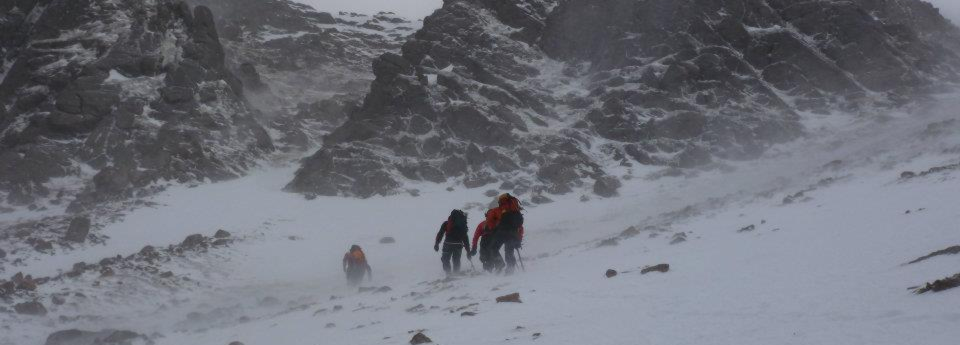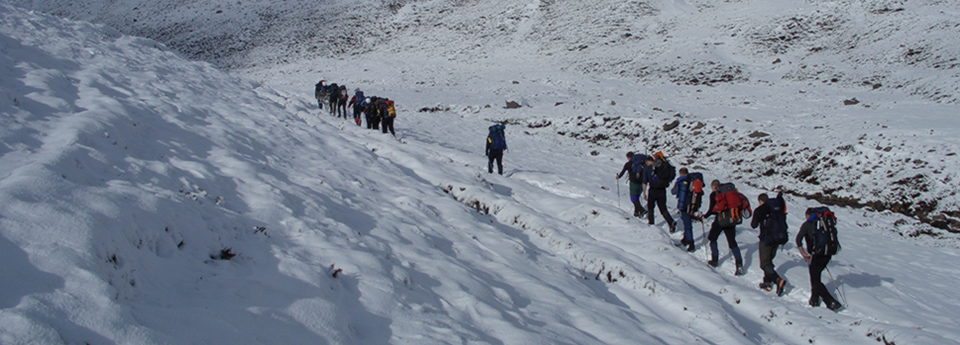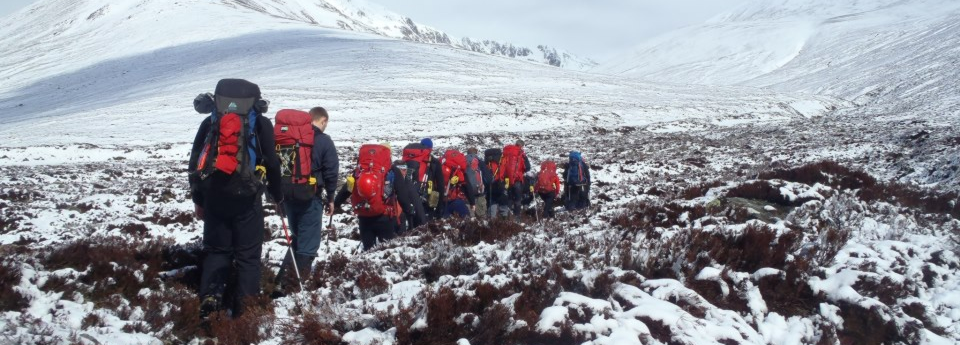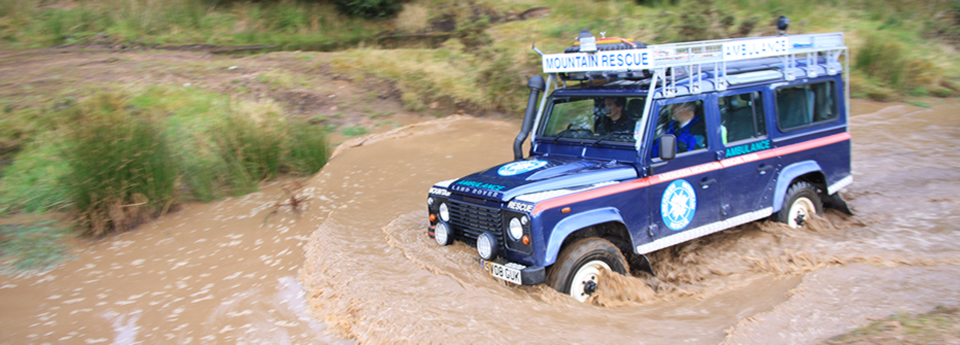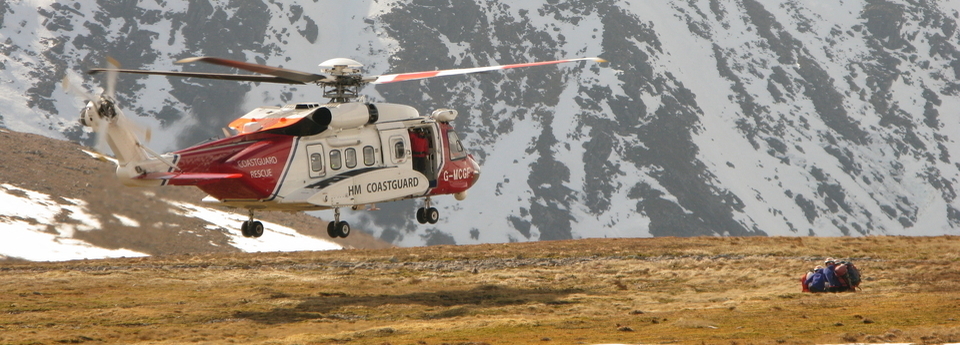Team Leaders' Report 2007
The early indications were that the winter of 2006/2007 was going to follow a similar pattern to the winters of the previous few years – little in the way of prolonged snowfall, and as a consequence a relatively quiet winter for Scottish mountain rescue teams. In fact the winter proved to be something of a mixed bag – what snow there was came quite late, but not really in any great quantity, even in the hills, and although there were a number of incidents in the Cairngorms few of them were, from a mountain rescue point of view, very significant.
On looking back over the last few years we have begun to see a changing pattern emerge in relation to the number of callouts, and also when in the course of the year they take place. Gone, it would appear are the days when we could reasonably expect to be busiest in the depths of a snowy winter – indeed over the last five or so years the Team has consistently recorded more callouts during the summer and autumn months than during the winter. What was perhaps most significant about 2007, was the generally appalling wet weather which characterised much of the year, and gave rise to some interesting conditions on the hills and as a direct result. some significant “summer” callouts.
In early August the Team was involved in two quite major callouts in the course of a single weekend. One callout, which resulted from a party getting stuck on Eagles Ridge on Lochnagar following the onset of heavy rain, required a major effort by all the local teams. Deteriorating weather conditions, and the fact that one of the cragfast climbers had been stuck on a stance for some ten hours, created a difficult situation. Teams were deployed to the top of the cliff and also to the base of the climb. The cragfast climber was eventually rescued from the cliff by a member of the Braemar rescue team, who was lowered seven hundred feet from the top of the cliff. Fortunately, the climber was uninjured and was able to walk out from the base of the climb, escorted by members of the Aberdeen Team – by which time the deteriorating weather would not have disgraced a mid winter day in January.
Two days later and we were all out again looking for two walkers who were reported overdue from a walk in the central Cairngorms. Heavy rain over the previous two days had created significant problems in terms of some of the burns, and there was initial concern that we might not be able to get to the search area, which was initially identified as Ben Mheadhoin. Fortunately we were able to call on the services of a search and rescue helicopter from RAF Lossiemouth. The helicopter was able to ferry all the Team into Etchachan and we deployed from there. As the weather gradually improved we searched over Ben Mheadhoin – meanwhile the helicopter was able to cover the area as the cloud lifted, and around mid morning it spotted the two missing walkers and was able to evacuate them safely out to Glenmore Lodge.
Training & Membership
Training as ever continues to be an important focus of our activities – the need to maintain a high level of operational effectiveness underpins all that we do as a mountain rescue team. During 2007 we involved Team members in a wide variety of training scenarios; some of these were designed to enhance our first aid and casualty handling skills, whilst others addressed the need to provide Team members with the expertise to drive our vehicles safely off-road. Central of course, to all of our training, is the need to maintain a high level of proficiency in all the basic mountaineering skills, and also to ensure that Team members have a good local knowledge of our “patch”. Our training weekends are designed to allow Team members to do all of these things during the course of a yearlong training cycle. Having said this however, the lack of decent winters over the last few years has certainly presented us with challenges when it comes to undertaking high quality winter training. Nevertheless, we have generally been able to cover the essentials, although some of our “younger” team members are, I think, beginning to wonder if the stories of long snowy winters with good ice climbing and great ski touring conditions. are simply figments of the old hands memories! Who knows maybe these days will come again.
Team training takes place on seventeen weekends spread throughout the year and this constitutes a very significant commitment for all Team members. Training with other local teams and with the RAF search and rescue helicopters forms a very important part of our overall training programme, and during 2007 we held a number of joint training exercises which help team members to share information and skills. These events always prove fruitful and are an excellent way to disseminate information. and to encourage debate about the best way of tackling a technical rescue problem. It is also a very good way of ensuring Team members from a number of different teams get to know each other – this can have real benefits when teams are required to work together under difficult and stressful situations.
For most of 2007 Team membership was around thirty and this has remained quite steady now for the past two or three years. It remains a challenge however, to recruit suitable Team members, and although we do get a reasonably steady stream of potential recruits, I think that the commitment which we ask, of Team members is for many, quite daunting. It is really interesting to note that over the past ten or so years the age profile of the Team, in common with almost all Scottish Rescue Teams, has become something of a cause for concern. I think that one of the biggest challenges facing us over the next ten years will be to recruit a sufficient number of “young” team members to ensure that the Team can not only maintain its effectiveness, but also has the right age profile to continue and develop.
Equipment & Accommodation
In the course of 2007 we decided that two of our trailers needed to be replaced. The Team currently operates three long wheelbase landrovers, each one pulling a custom built trailer. Two of the trailers are designed to carry team members’ personal equipment, and we had become increasingly concerned about security when the trailers have to be left at the side of the road in the event of a callout. Although this does not happen very often, it is always something which we have to think about, and given the potential replacement cost of equipment and the ease with which a tarpaulin over an open trailer can be “breached”, we felt that it was time to do something about this. Two new trailers have now been purchased – each with a robust lockable aluminium cover; hopefully this will ensure that on those occasions when we are required to leave vehicles unattended at the side of the road, that we can be reasonably confident that the equipment will still be there when we return.
During 2007 we have also had to put a significant amount of effort into maintaining our two bothies at the Spittal of Muick and at Derry. These buildings are absolutely central to the work of the Team, and provide forward bases for rescues, and centres out of which we can organise training. The buildings have over the years been highly customised, and a regular programme of maintenance ensures that they are warm and comfortable buildings to come back to after a day out, be it on a rescue or a training exercise. The buildings have over the years seen many memorable callouts and the Team owes a considerable debt of gratitude to the Balmoral and Mar Lodge estates for supporting us over these many years. I think that as a Team we have developed a very positive and constructive relationship with many of the local estates over the years, and their continued good will is of course something which we value, and is indeed vital to the ongoing operational effectiveness of the Team.
Although the Team's main focus of activity is of course mountain rescue, we have over many years developed an important secondary role with local hill walking and mountaineering clubs as a source of advice on mountain safety. In the course of an average year members of the Team will undertake a wide variety of talks and demonstrations, all designed to raise the awareness of walkers and climbers to the potential hazards of a day out on the Scottish hills. The feedback, which we get from these talks is very positive and helps, I believe, to develop an important and positive connection between the Team and the local mountaineering community. I would also like to think that the advice we have provided over the years has helped to prevent incidents on the hill, and perhaps given walkers and climbers a better perspective on how to stay safe when out for a day on the hills. Opportunities to talk to youth organisations such as Scouts and Guides also provide a means of perhaps encouraging young people into the idea that at some point in the future membership of a rescue team is something that they might want to consider.
As another year passes I am, as always, struck by the tremendous commitment which Team members give to the organisation. Their willingness to turn out in the worst of weather and their good-natured enthusiasm is something that money simply could not buy. The commitment of course goes well beyond turning out for callouts – maintaining vehicles and equipment is absolutely vital, and, although not perhaps as glamorous as callouts, the long hours spent in a cold garage doing all the behind the scenes jobs is an essential part of ensuring that when a “shout” does come, everything is where it should be and working!
Reflections!
As I enter my thirty-eighth year in the Team and my sixteenth year as Team leader I can reflect back on a lot of interesting times. I have been a member of the Team virtually all of my adult life and I consider myself to have been fortunate indeed to have had the opportunity to be involved with such a remarkable organisation and some equally remarkable people. The changing nature of mountain rescue and the different pattern of callouts throughout the year will, together with the challenge of recruiting new Team members, give us much to think about over the months and years ahead. The one thing that I am confident of is, that the Team will continue to benefit from the dedication, commitment and effort of its members. In an uncertain world it is difficult to make predictions; however, having watched the development of mountain rescue over almost forty years, one thing I am certain of is that the need for well trained, geographically distinct mountain rescue teams will remain. The challenge is to ensure that these teams remain well equipped and supported.
In the course of 2007 the Team was once again well supported by the Aberdeen and St John Mountain Rescue Association. The Association has acted in the role of “parent body” for the Team almost since it’s formation, and over the years they have done a sterling job in providing financial and moral support for the Team. We have been very fortunate in that a number of other local organisations have seen fit to support us financially, or in kind throughout the year and our thanks go out to them for thinking about us.
Finally, I would like to thank all the members of the Team, past and present, for their dedication and commitment to mountain rescue. I would also like to say a special thanks to those people, be they family or friends, who provide the behind the scenes support for team members – we are all very conscious that without your support and tolerance, maintaining our involvement in mountain rescue would be extremely difficult.
Mario Di Maio
Team Leader

